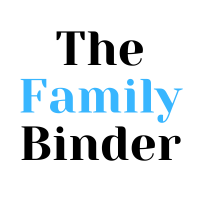Imagine never losing a file, forgetting a password, or feeling overwhelmed by digital clutter again. In today’s fast-paced world, keeping your digital life in order is just as important as organizing your physical space.
This guide is designed to help you become a digital home organizer, transforming your routines and streamlining every aspect of your home’s digital landscape.
Discover the latest tools, step-by-step decluttering strategies, smart home integrations, security best practices, and emerging trends that will keep your household running smoothly in 2025.
Understanding Digital Home Organization in 2025
Imagine your home as a digital ecosystem, where every document, photo, and account is as easy to find as your favorite coffee mug. The concept of the digital home organizer has evolved rapidly, keeping pace with new technology and shifting lifestyles. To truly appreciate these advances, let’s explore how digital home organization has changed and why it matters more than ever.
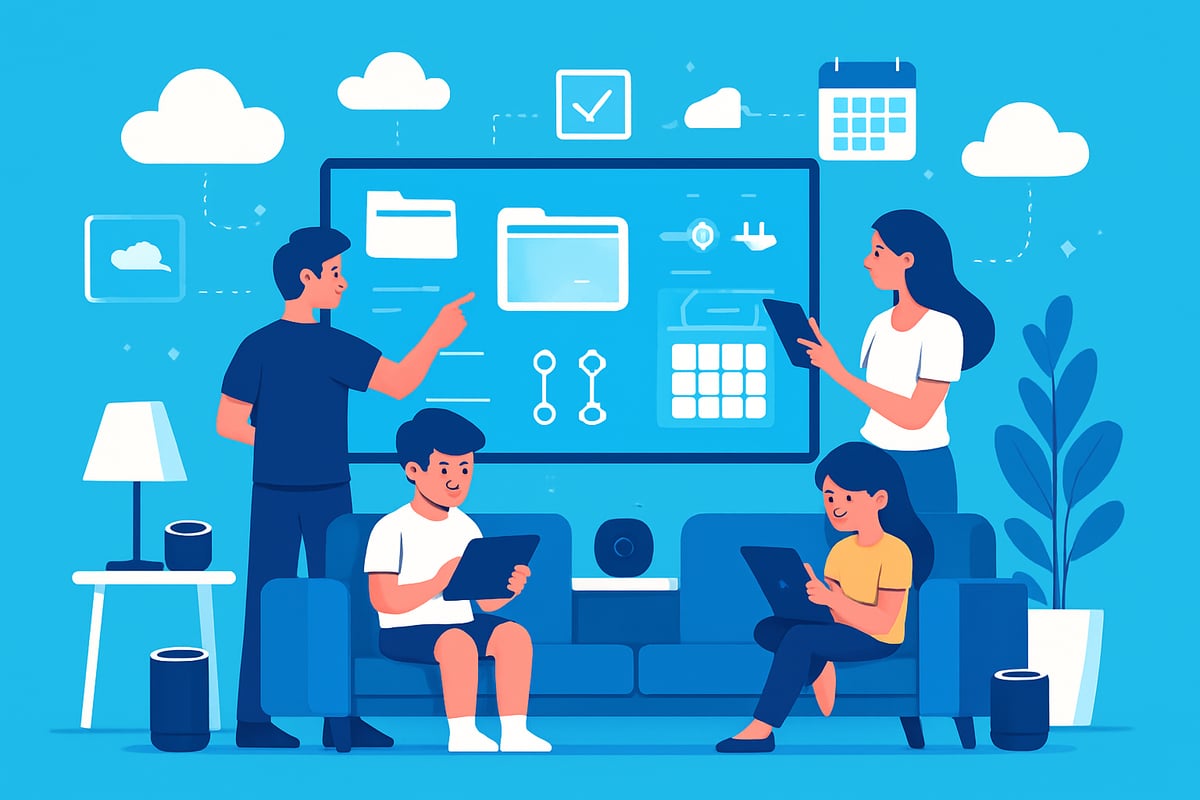
The Evolution of Home Organization
Just a decade ago, home management meant stacks of paper, overflowing filing cabinets, and sticky notes everywhere. Now, the digital home organizer is at the center of a new wave. Cloud storage has replaced bulky folders, and smart devices have become part of daily routines. With remote and hybrid work more common, families need flexible solutions. In fact, 45% of households now use cloud-based storage for home documents (Statista, 2024).
This shift means organization is no longer just about tidiness; it’s about digital access and security. The digital home organizer is now a tool for efficiency, letting you find what you need with a few clicks.
Benefits of a Digitally Organized Home
A digital home organizer brings a host of benefits that go beyond a tidy desktop. Imagine saving hours each month simply by having your files, photos, and passwords at your fingertips. No more frantic searches before appointments or tax season.
Here’s what a digital home organizer can do for you:
- Save time finding important documents
- Reduce stress and mental clutter
- Boost productivity and family communication
According to the Home Organization Institute (2023), families with digital organization systems spend 30% less time on routine tasks. With a digital home organizer, you can spend more time on what matters and less on hunting down files.
Common Digital Clutter Challenges
Even with powerful tools, digital clutter sneaks up on everyone. The digital home organizer must tackle common issues like duplicate files, old documents, and forgotten passwords. Many households have thousands of untagged photos, scattered across devices and cloud accounts.
The average family juggles over 10,000 digital photos, with 60% remaining untagged (Photo Management Survey, 2024). Forgotten logins can lock you out of important accounts, adding to frustration. For more practical strategies, check out these Digital Record Keeping Tips, which can help you streamline your digital home organizer approach.
Why 2025 Demands Smarter Solutions
With the rise of smart home devices and the Internet of Things, the digital home organizer is more crucial than ever. The average household now manages at least three smart devices (Pew Research, 2024). This growth brings new challenges, including cybersecurity risks and the need for accessible family information.
A digital home organizer helps keep your data safe, your devices connected, and your family’s essential information at your fingertips. As technology evolves, so does the need for smarter, more integrated solutions that protect and empower your household.
Step-by-Step Guide to Decluttering Your Digital Space
Ready to turn digital chaos into calm? The digital home organizer approach breaks down the process into manageable steps, making it easy to reclaim your devices, files, and routines. No matter how overwhelming your clutter may seem, following these proven strategies will help you create a system that lasts.
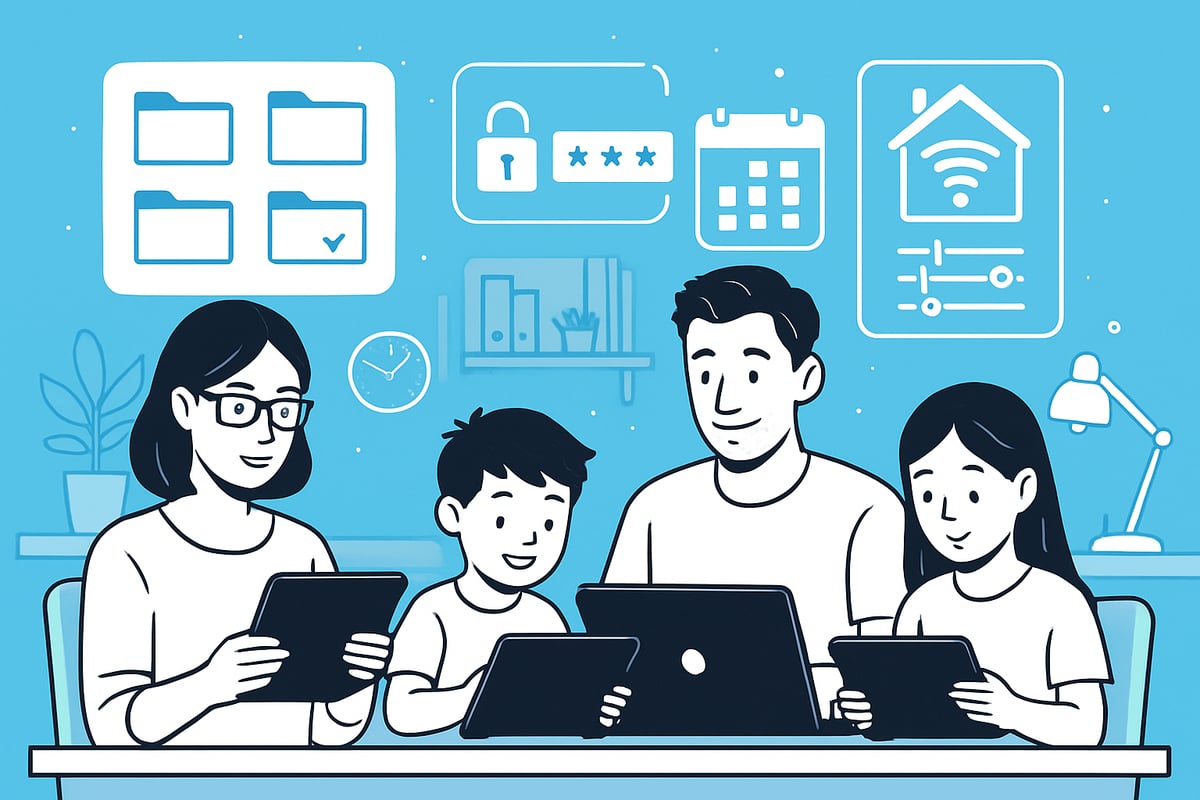
Step 1: Audit Your Digital Assets
Begin by taking inventory of every device, account, and storage location in your home. The digital home organizer method recommends tracking everything from laptops and smartphones to cloud drives and external hard disks.
List all your email accounts, cloud services, and digital storage mediums in a spreadsheet or organization app. This comprehensive overview will reveal where your digital clutter hides, helping you spot forgotten corners of your digital life.
A detailed audit sets the stage for a truly organized digital home, ensuring nothing slips through the cracks.
Step 2: Categorize and Prioritize Files
Next, use your digital home organizer to group files by type, such as documents, photos, videos, and financial records. Organize each category based on importance and how often you use it.
Color-coding, tagging, or labeling files can make retrieval much easier. For example, urgent documents might be tagged red, while personal photos get a blue label.
By setting clear priorities, you’ll spend less time searching and more time getting things done. This step streamlines your digital world and keeps your focus where it matters most.
Step 3: Delete, Archive, or Consolidate
Now it’s time for the digital home organizer to work its magic. Identify and remove duplicate files, outdated documents, and anything you no longer need.
Archive essential but rarely accessed files in secure, labeled folders. Consolidate scattered items into centralized locations for easy retrieval. Research shows that clutter can significantly impact productivity and mental health—learn more about the clutter impact on productivity to understand why this step is so crucial.
A regular purge keeps your digital space light, efficient, and stress free.
Step 4: Organize Photos and Media
Digital photo and media libraries can quickly become overwhelming. Your digital home organizer should leverage tools like Google Photos or Apple Photos, which offer facial recognition and automatic tagging features.
Create albums by event, year, or family member for easy navigation. Use metadata and tags to make searching for specific memories a breeze.
By maintaining a logical structure, you’ll preserve precious moments and avoid the stress of endless scrolling. This keeps your digital memories as organized as your physical ones.
Step 5: Password and Account Management
Password chaos is a common pain point. A digital home organizer strategy involves using reputable password managers to store credentials securely.
Update weak or duplicate passwords and enable two-factor authentication wherever possible. Keep a master list of accounts and logins, but never store it in plain text.
With strong password hygiene, you protect your information and save time logging in, making your digital routines safer and more efficient.
Step 6: Set Up Digital Calendars and Reminders
Centralized calendars are a cornerstone of any digital home organizer routine. Sync family or household calendars across devices, ensuring everyone is on the same page.
Automate reminders for bills, appointments, and important maintenance tasks. Shared tools like Google Calendar can help coordinate schedules and reduce missed deadlines.
With digital calendars, your home runs smoothly, and everyone stays informed without constant reminders.
Step 7: Maintain with Scheduled Check-Ins
Organization is not a one time event. Your digital home organizer system thrives with regular check ins. Schedule monthly or quarterly sessions to review and update your digital structure.
Make it a family event, like a “digital cleanup day,” so everyone contributes to maintaining order. Set recurring reminders to audit files, update passwords, and review your organizational tools.
Consistent maintenance ensures your digital home stays clutter free, efficient, and ready for whatever 2025 brings.
Essential Tools and Apps for Digital Home Organization
The right digital home organizer tools can transform chaos into calm. With so many apps and platforms available in 2025, picking the right ones for your needs is essential. Let’s break down the top options for every aspect of home management, from file storage to family coordination.
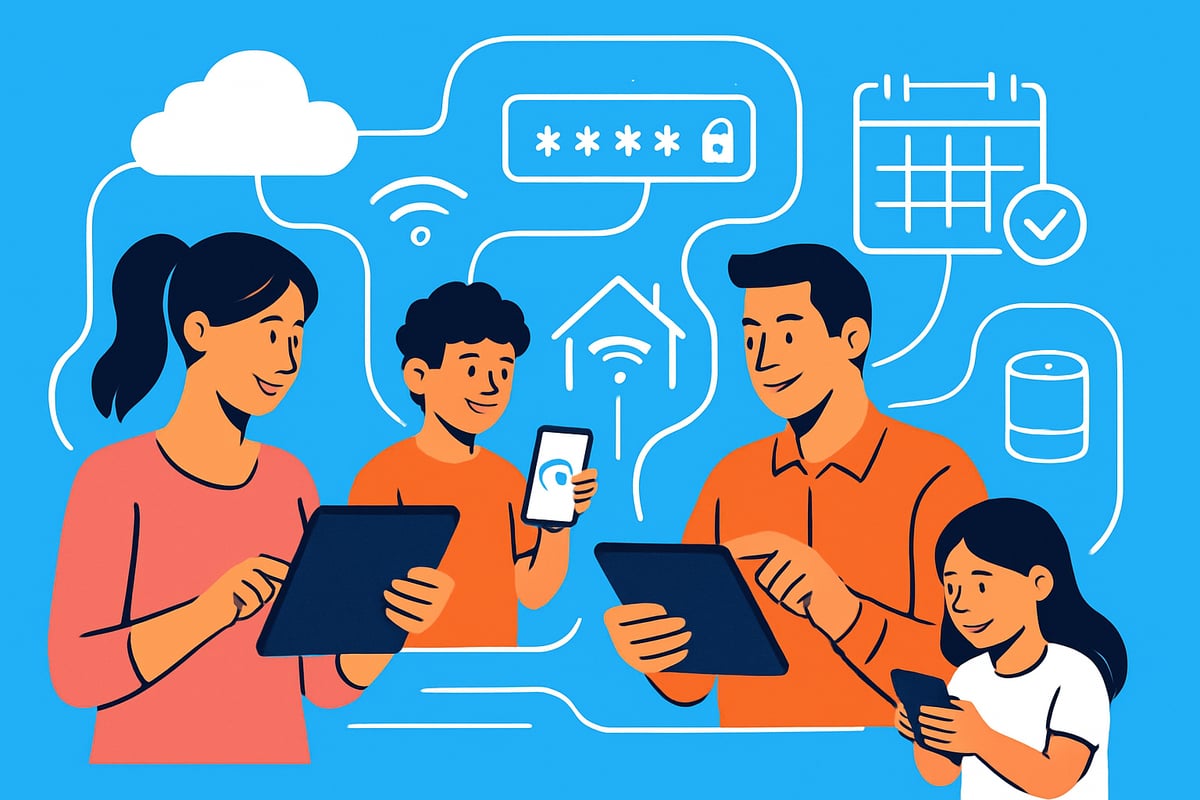
Top Cloud Storage Solutions
Choosing a reliable cloud storage platform is the backbone of any digital home organizer system. Google Drive, Dropbox, and OneDrive are the leading contenders, each offering unique strengths.
| Service | Free Storage | Integration | Security Features |
|---|---|---|---|
| Google Drive | 15GB | Google Workspace | Two-factor auth |
| Dropbox | 2GB | Third-party apps | File recovery |
| OneDrive | 5GB | Microsoft ecosystem | Personal Vault |
Cloud storage makes sharing, backing up, and collaborating on files effortless. For most families, Google Drive stands out with generous storage and easy sharing, keeping your digital home organizer workflow seamless and accessible from any device.
Best Password Managers
A digital home organizer is only as strong as its password management. Top options include LastPass, 1Password, and Bitwarden. These tools store and autofill complex passwords, so you don’t have to remember dozens of logins.
- LastPass: Offers browser extensions and family plans.
- 1Password: Enables secure sharing among family members.
- Bitwarden: Open-source with strong encryption.
Password managers centralize credentials, reduce the risk of password reuse, and even alert you to weak passwords. Incorporating a password manager into your digital home organizer routine adds a vital layer of security for everyone at home.
Digital Note-Taking and Document Management
Keeping digital notes, manuals, and important documents organized is critical for a digital home organizer. Leading apps like Evernote, Notion, and Microsoft OneNote let you create, tag, and search for information instantly.
- Store recipes, warranties, and receipts.
- Use templates for home inventories.
- Sync notes across all devices.
Notion’s flexible templates, for instance, are perfect for tracking home projects and lists. With a digital home organizer app, you’ll never waste time searching for instructions or paperwork again.
Home Inventory and Asset Tracking Apps
Tracking valuables and household assets is easier with dedicated apps. Digital home organizer favorites include Sortly, Encircle, and BluePlum Home Inventory.
- Sortly: Barcode scanning and photo attachments.
- Encircle: Insurance documentation and reporting.
- BluePlum: Visual inventory by room.
These apps simplify insurance claims and help you keep tabs on warranties and maintenance. The right digital home organizer tool ensures every item is accounted for, making emergencies or moves less stressful.
Smart Calendar and Task Management Tools
Coordinating family schedules is a breeze with smart calendars and task apps. Google Calendar, Todoist, and Cozi Family Organizer enable sharing, color-coding, and automated reminders.
- Assign chores and appointments.
- Sync events across devices.
- Track progress and deadlines.
For a deep dive into setting up a family digital command center, check out this guide on Family Digital Command Center Setup. Integrating these tools into your digital home organizer ecosystem ensures everyone stays on the same page.
Automation and Integration Platforms
Automation tools like IFTTT and Zapier are the secret weapon for any digital home organizer. These platforms connect your favorite apps and devices, automating repetitive tasks and routines.
- Schedule automatic file backups.
- Set up smart home routines.
- Trigger reminders or alerts across platforms.
By automating workflows, the digital home organizer experience becomes more hands-off, efficient, and future-ready. Regularly review your automations to keep them aligned with your household’s evolving needs.
Integrating Smart Home Devices for Seamless Organization
Imagine your home as a living network, where every device, file, and task is connected and easily managed. Integrating smart home technology transforms your space into a true digital home organizer, bringing efficiency and peace of mind to your daily routine.
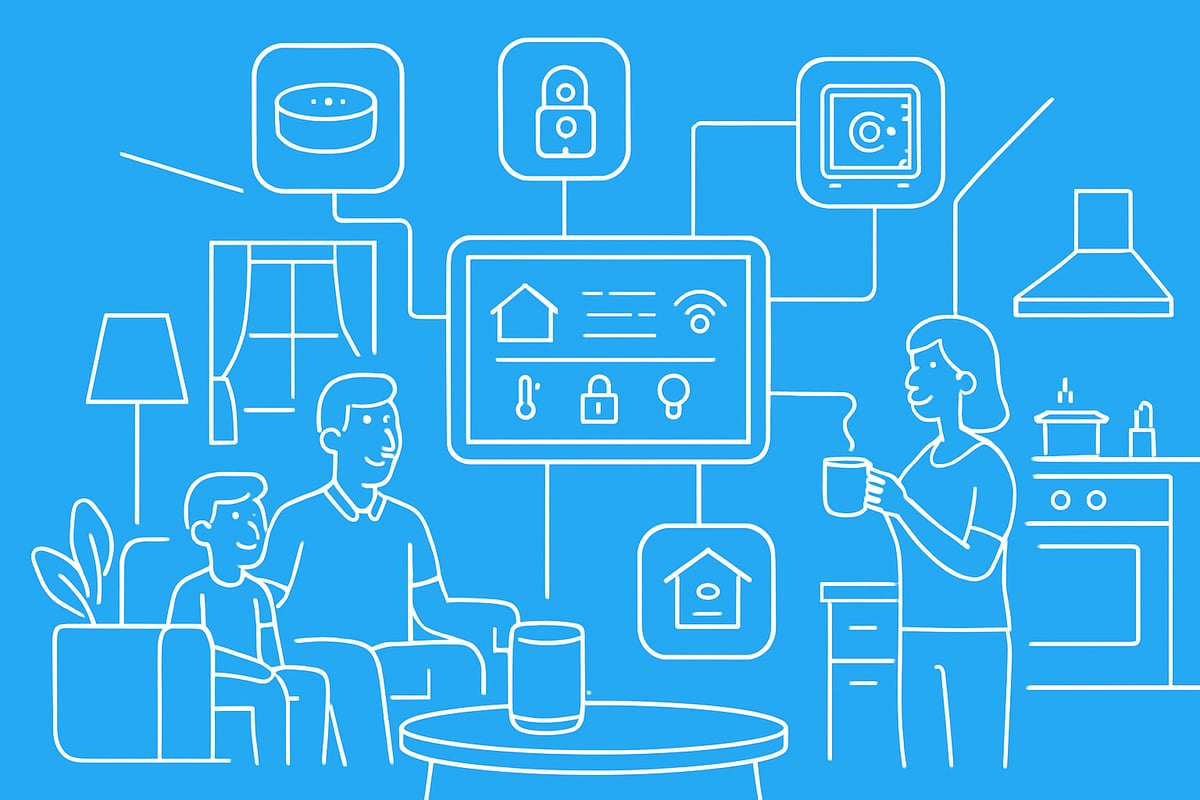
Smart Hubs and Voice Assistants
Smart hubs and voice assistants are the command centers of any digital home organizer. Devices like Amazon Alexa, Google Home, and Apple HomeKit centralize control, letting you manage calendars, reminders, and smart appliances with simple voice commands.
Picture asking your assistant to add an event, turn off lights, or remind the family about appointments—all hands-free. These hubs sync with other devices, making routine tasks easier and reducing the chaos of multiple apps or remotes.
For families, smart hubs also allow shared access, so everyone stays updated and connected. Integrate these tools to streamline your digital home organizer setup and keep your household running smoothly.
Smart Storage Solutions
Today’s smart storage solutions combine digital tracking with physical security, making them a core part of any digital home organizer. Digital locks and smart safes, for example, protect valuables and sensitive documents while offering app-based access logs for peace of mind.
RFID-tagged storage bins and cabinets help you locate items instantly, reducing time spent searching for essentials. This shift reflects a larger trend, as highlighted in the home storage and organization market growth, with more households seeking tech-enabled organization options.
By pairing these smart storage systems with your digital home organizer, you create a seamless bridge between your physical and digital assets, ensuring everything is accounted for and secure.
Connected Appliances and Maintenance Reminders
Appliances are getting smarter, and they play a vital role in your digital home organizer ecosystem. Smart fridges can monitor groceries, send alerts when supplies run low, and even suggest shopping lists. Washers and dryers schedule maintenance and notify you about cycle completion.
Thermostats, meanwhile, track energy use and adjust settings for maximum comfort and efficiency. By connecting these appliances to your digital home organizer, you automate routine tasks and minimize manual effort.
Maintenance reminders and alerts keep your home running smoothly, so you never miss a filter change or warranty expiration. This proactive approach saves time and extends the life of your investments.
Home Security and Access Management
Security is a cornerstone of any digital home organizer. Video doorbells, smart locks, and security cameras allow you to monitor entry points, receive real-time notifications, and grant access remotely.
Integrating these devices with centralized digital platforms means you can check camera feeds, review access logs, or unlock doors—all from your smartphone or control hub. This level of oversight enhances safety and convenience for every family member.
With a robust digital home organizer, you can confidently manage who comes and goes, ensuring your property and loved ones remain protected.
Data Privacy and Security for Smart Homes
A truly effective digital home organizer goes beyond convenience—it prioritizes data privacy and security. Encrypting data, regularly updating device firmware, and managing app permissions are essential habits for safeguarding your smart home.
Schedule periodic reviews of device access settings to prevent unauthorized entry. Enable two-factor authentication where possible and keep an inventory of connected devices. These practices not only protect your digital home organizer ecosystem but also foster peace of mind in an increasingly connected world.
Digital Organization for Families: Collaborative Systems and Best Practices
A truly organized home is more than just neat shelves and tidy drawers. In 2025, a digital home organizer is essential for families who want to collaborate, communicate, and keep life running smoothly. Let’s explore the best practices for building a digital family command center, managing kids’ screen time, securely sharing documents, tracking chores, and future-proofing your family’s digital legacy.
Creating a Family Digital Command Center
Start your journey with a centralized command center that acts as the heart of your digital home organizer setup. This digital hub brings together shared calendars, contact lists, and vital information in one accessible location for everyone.
Consider using cloud-based platforms like Google Workspace or Microsoft 365 to create shared drives and folders. These tools help families store school schedules, meal plans, and emergency contacts all in one place. For those who love a tactile approach, blending digital and physical organization, the Home Organization Binder Guide offers inspiration for digitizing traditional binders.
A digital home organizer command center not only streamlines information but also empowers every family member to find what they need, when they need it.
Managing Kids’ Digital Lives and Screen Time
Children’s digital lives can quickly become overwhelming without the right digital home organizer systems. Set up parental controls on devices, limit screen time, and monitor app usage to encourage healthy habits.
Use features like Apple Screen Time or Google Family Link to set daily limits and approve downloads. Educational apps and safe browsing filters add another layer of protection. Create a family agreement outlining rules for device use, and review these guidelines regularly.
A digital home organizer makes it easy to balance learning and leisure, ensuring your kids stay safe and productive online.
Sharing and Storing Important Family Documents
Every family accumulates critical documents, from birth certificates to insurance policies. A digital home organizer is the safest way to store and share these files securely.
Choose encrypted cloud storage solutions, such as Google Drive or Dropbox, and organize documents into clearly labeled folders. Limit access to sensitive files, and set up sharing permissions so only authorized family members can view or edit them.
For extra security, keep digital copies of IDs, medical records, and financial documents in password-protected folders. This approach ensures your family’s essential information is always within reach, even during emergencies.
Coordinating Schedules and Chores Digitally
Juggling everyone’s activities is easier with a digital home organizer. Shared digital calendars, like Google Calendar or Cozi, allow families to visualize appointments, school events, and vacations in one place.
Assign chores using family task apps, and track progress with reminders and notifications. Color-coded calendars help each member see their responsibilities at a glance. Gamified apps, such as ChoreMonster, can motivate kids to complete tasks by turning chores into fun challenges.
With a digital home organizer, keeping everyone on track becomes a collaborative, stress-free process.
Digital Legacy and Estate Planning Tools
Planning for the future is a vital aspect of any digital home organizer system. Organize wills, estate documents, and account access details in secure, easily accessible locations.
Assign digital heirs for important online accounts, and use tools like Google’s Inactive Account Manager to manage your digital legacy. For a comprehensive approach, the Digital Estate Planning Essentials guide walks families through safeguarding digital assets for the next generation.
A thoughtful digital home organizer strategy ensures your family’s information is protected and accessible, no matter what the future holds.
Future Trends in Digital Home Organization
The future of digital home organizer solutions is evolving rapidly, driven by new technologies and changing lifestyles. As we look ahead to 2025, several key trends are shaping how families manage, protect, and optimize their digital spaces. Staying ahead of these trends ensures your digital home organizer system remains both effective and future-proof.
AI and Automation in Home Management
Artificial intelligence is transforming the digital home organizer landscape. AI-powered tools now sort, label, and prioritize files automatically, saving hours of manual work. Predictive organization means your system learns your habits, suggesting smart folders or reminding you to back up important documents.
AI assistants can even automate daily routines, such as sending reminders for bill payments or creating grocery lists. As the home organization market value forecast shows, demand for these smart solutions is rising, reflecting their growing importance in modern homes.
The Rise of Virtual and Augmented Reality Organizers
Virtual and augmented reality are making waves in the digital home organizer world. Imagine donning VR goggles to tour your digital files or using AR apps to locate a physical item by overlaying digital tags in real time. This immersive technology makes organizing intuitive and interactive.
Some platforms now let users create virtual walkthroughs of their spaces, planning storage or labeling items visually. These advancements empower users to experience their digital home organizer system in ways that were once science fiction.
Sustainability and Eco-Friendly Digital Organization
Sustainability is at the forefront of digital home organizer trends. More families are choosing digital receipts, e-bills, and cloud-based records to cut down on paper waste. Modern smart home devices are designed to be energy efficient, reducing the environmental impact of daily routines.
By integrating green practices into your digital home organizer setup, you help create a more eco-friendly household. Small changes, like switching to digital documentation, can make a significant difference over time.
Preparing for Digital Emergencies and Backups
A future-ready digital home organizer system must include robust backup and disaster recovery plans. Automated cloud backups protect your data from accidental loss, device failure, or cyberattacks. Setting up redundancy ensures that your most important files are always safe and accessible.
According to recent surveys, households without a solid backup routine are far more likely to lose critical information. Investing in a digital home organizer with strong backup features provides peace of mind and long-term security.
If you’re ready to put these digital organization tips into action and truly simplify your home life in 2025, there’s an easier way to get started. Imagine having every important detail—finances, insurances, home info, kids’ schedules, even your estate plans—all organized in one place and ready when you need it. That’s exactly what The Family Binder does, and it’s as simple as filling in the blanks. No more scrambling for documents or searching for passwords—just peace of mind for you and your family. Take your next step to a streamlined, stress-free home and Download Now.
